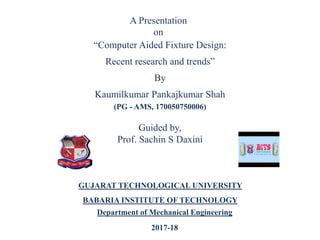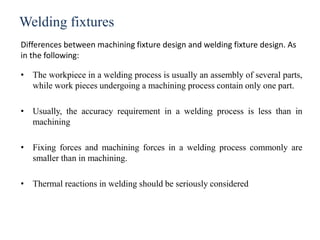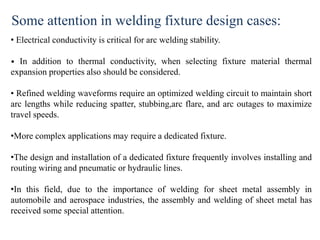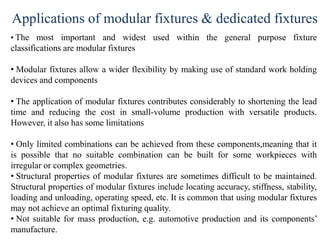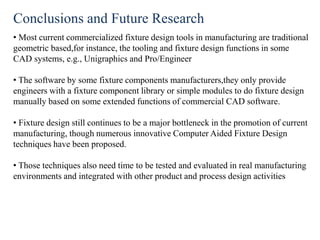Need fixture for Manufacturing
- 1. “Computer Aided Fixture Design: Recent research and trends” By Kaumilkumar Pankajkumar Shah (PG - AMS, 170050750006) GUJARAT TECHNOLOGICAL UNIVERSITY BABARIA INSTITUTE OF TECHNOLOGY Department of Mechanical Engineering 2017-18 A Presentation on Guided by, Prof. Sachin S Daxini
- 2. Fixture in Manufacturing • A fixture is a mechanism used in manufacturing to hold a workpiece ,position it correctly with respect to a machine tool, and support it during machining. • Fixtures have a direct impact upon product quality, productivity and cost. • Approximately 40% of rejected parts are due to dimensioning errors that are attributed to poor fixturing design. • A fixture is designed to position and hold one or more workpiece(s) within some specifications. It is widely used in manufacturing, • For example, machining (including turning, milling, grinding, drilling, etc), welding, assembly, inspection and testing.
- 3. Welding fixtures • The workpiece in a welding process is usually an assembly of several parts, while work pieces undergoing a machining process contain only one part. • Usually, the accuracy requirement in a welding process is less than in machining • Fixing forces and machining forces in a welding process commonly are smaller than in machining. • Thermal reactions in welding should be seriously considered Differences between machining fixture design and welding fixture design. As in the following:
- 4. Some attention in welding fixture design cases: • Electrical conductivity is critical for arc welding stability. • In addition to thermal conductivity, when selecting fixture material thermal expansion properties also should be considered. • Refined welding waveforms require an optimized welding circuit to maintain short arc lengths while reducing spatter, stubbing,arc flare, and arc outages to maximize travel speeds. •More complex applications may require a dedicated fixture. •The design and installation of a dedicated fixture frequently involves installing and routing wiring and pneumatic or hydraulic lines. •In this field, due to the importance of welding for sheet metal assembly in automobile and aerospace industries, the assembly and welding of sheet metal has received some special attention.
- 5. • A weld fixture is often developed to reduce the deformation of each workpiece due to heat and residual stress in the welding process and, hence, to reduce the dimensional variation of the assembly •Therefore, some methods of offline or online deformation analysis were developed to enhance the fixtures’ ability on deformation controlling • In sheet metal assembly with laser welding fixtures also should ensure a fit-up of the mating surfaces to ensure proper laser beam weld operation and laser weld quality.
- 6. Applications of modular fixtures & dedicated fixtures • The most important and widest used within the general purpose fixture classifications are modular fixtures • Modular fixtures allow a wider flexibility by making use of standard work holding devices and components • The application of modular fixtures contributes considerably to shortening the lead time and reducing the cost in small-volume production with versatile products. However, it also has some limitations • Only limited combinations can be achieved from these components,meaning that it is possible that no suitable combination can be built for some workpieces with irregular or complex geometries. • Structural properties of modular fixtures are sometimes difficult to be maintained. Structural properties of modular fixtures include locating accuracy, stiffness, stability, loading and unloading, operating speed, etc. It is common that using modular fixtures may not achieve an optimal fixturing quality. • Not suitable for mass production, e.g. automotive production and its components’ manufacture.
- 7. The dedicated fixtures are also important in manufacturing, particularly, for advanced, sophisticated and precise part or mass production. Because a dedicated fixture is designed for a specific product, the designer can carefully tailor the design to not only meet the basic fixturing requirements such as the locating accuracy,stability, stiffness, but also optimally facilitate the operational requirements such as loading/unloading convenience and efficiency, and effective chip disposal etc. • Compared with modular fixtures, dedicated fixtures are designed carefully according to workpiece’s design and manufacturing requirements. So there are more uncertainties imposed on dedicated fixture design tasks. • In modular fixture design, there is a component library with pre-designed and dimensioned standardized fixture components. •Thus, the modular fixture configuration design is actually to assemble the fixture components into a configuration. •Modular fixture elements such as basep lates, locators, supports and clamps are stored in a database.
- 8. Fixture design verification • Fixture verification is an integrated part of the design process and must allow for the detection of any interference that may occur during the fixture’s construction, Verification of a fixture design solution is necessary for the following reasons: • There are too many factors involved in the design process; it is very difficult to establish accurate analysis models in the process • Design constraints are considered individually; some contradicting constraints may be produced when they are considered together. • Fixture design has a close relationship with other activities (such as Computer- Aided Process Planning, and Computer-Aided Manufacturing) in a manufacturing system; the design solution needs to be verified as practicable for the whole manufacturing system.
- 9. Conclusions and Future Research • Most current commercialized fixture design tools in manufacturing are traditional geometric based,for instance, the tooling and fixture design functions in some CAD systems, e.g., Unigraphics and Pro/Engineer • The software by some fixture components manufacturers,they only provide engineers with a fixture component library or simple modules to do fixture design manually based on some extended functions of commercial CAD software. • Fixture design still continues to be a major bottleneck in the promotion of current manufacturing, though numerous innovative Computer Aided Fixture Design techniques have been proposed. • Those techniques also need time to be tested and evaluated in real manufacturing environments and integrated with other product and process design activities

